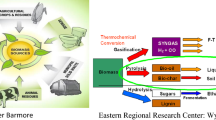Abstract
A series of experiments on a black non-charring polymer in the low-pressure chamber is conducted under different external heat fluxes. The surface and bottom temperatures and the mass loss of the sample are measured. A parameter T p is introduced to describe the impact of pressure on the surface temperature. There is a loose layer of the char residue left with significant pyrolysis bubbles under the low heat flux, and the bubble size decreases with pressure. The parameter T p is found to exhibit a significant decline trend with increasing pressure, and the mass loss rate of the sample decreases apparently as the pressure increases. However, under a high heat flux, the char residue is denser, and the pyrolysis bubbles are not observed. The value of T p and the mass loss rate of the sample have no obvious relationship with pressure. The average pyrolysis rate is linearly proportional to pa.
Similar content being viewed by others
References
J. Li and S. I. Stoliarov, “Measurement of Kinetics and Thermodynamics of the Thermal Degradation for Non-Charring Polymers,” Combust. Flame 160 (7), 1287–1297 (2013).
L. Basile, A. Tugnoli, and C. Stramigioli, “Influence of Pressure on the Heat of Biomass Pyrolysis,” Fuel 137, 277–284 (2014).
K. Lange, A. Perka, and B. Duffield, “Bounding the Spacecraft Atmosphere Design Space for Future Exploration Missions,” NASA/CR-2005-213689.
S. Mcallister, C. Fernandez-Pello, and D. Urban, “Piloted Ignition Delay of PMMA in Space Exploration Atmospheres,” Proc. Combust. Inst. 32 (2), 2453–2459 (2009).
J. Li, J. H. Gong, and S. I. Stoliarov, “Development of Pyrolysis Models for Charring Polymers,” Polym. Degrad. Stabil. 115, 138–152 (2015).
W. S. L. Mok and M. J. Antal, “Effects of Pressure on Biomass Pyrolysis. 2. Heats of Reaction of Cellulose Pyrolysis,” Thermochim. Acta 68 (2/3), 165–186 (1983).
C. J. Liang, X. D. Cheng, and K. Y. Li, “Experimental Study on Flame Spread Behavior Along Polymethyl Methacrylate Corner Walls at Different Altitudes,” J. Fire Sci. 32 (1), 84–96 (2014).
J. Qie, L. Yang, and Y. Wang, “Experimental Study of the Influences of Orientation and Altitude on Pyrolysis and Ignition of Wood,” J. Fire Sci. 29 (3), 243–258 (2011).
X.-K. Hu, Y.-P. He, and Z.-H. Li, “Combustion and Smoke Characteristics of Circle-Pan Fire under Low Pressure and Low Oxygen Concentration,” J. Combust. Sci. Technol. 2 (5), (2011).
M. Delichatsios and K. Saito, “Upward Fire Spread: Key Flammability Properties, Similarity Solutions and Flammability Indices,” Fire Saf. Sci. 3, 217–226 (1991).
S. Hulbert, “Models for Solid-State Reactions in Powdered Compacts—A Review,” J. Brit. Ceram. Soc. 6 (1), 11–20 (1969).
J. Sharp, G. Brindley, and B. N. Achar, “Numerical Data for Some Commonly Used Solid State Reaction Equations,” J. Amer. Ceram. Soc. 49 (7), 379–382 (1966).
E. A. Giess, “Equations and Tables for Analyzing Solid-State Reaction Kinetics,” J. Amer. Ceram. Soc. 46 (8), 374–376 (1963).
J. Quintiere, “A Theoretical Basis for Flammability Properties,” Fire Mater. 30 (3), 175–214 (2006).
S. Mcallister, C. Fernandez-Pello, and D. Urban, “The Combined Effect of Pressure and Oxygen Concentration on Piloted Ignition of a Solid Combustible,” Combust. Flame 157 (9), 1753–1759 (2010).
F. P. Incropera and D. P. DeWitt, Fundamentals of Heat and Mass Transfer (Wiley, 1985).
S. Fereres, C. Lautenberger, and C. Fernandez-Pello, “Mass Flux at Ignition in Reduced Pressure Environment,” Combust. Flame 158 (7), 1301–1306 (2011).
E. J. Kansa, H. E. Perlee, and R. F. Chaiken, “Mathematical Model of Wood Pyrolysis Including Internal Forced Convection,” Combust. Flame 29, 311–324 (1977).
C. Di Blasi, “Modeling and Simulation of Combustion Processes of Charring and Non-Charring Solid Fuels,” Prog. Energy and Combust. Sci. 19 (1), 71–104 (1993).
D. Wieser, P. Jauch, and U. Willi, “The Influence of High Altitude on Fire Detector Test Fires,” Fire Saf. J. 29 (2/3), 195–204 (1997).
Author information
Authors and Affiliations
Corresponding author
Additional information
Original Russian Text © R. Zong, R. Kang, Y. Zhi, C. Liu.
Published in Fizika Goreniya i Vzryva, Vol. 54, No. 3, pp. 64–71, May–June, 2018.
Rights and permissions
About this article
Cite this article
Zong, R., Kang, R., Zhi, Y. et al. Experimental Study on Pyrolysis of Black Non-Charring Polymers in the Reduced-Pressure Environment. Combust Explos Shock Waves 54, 309–315 (2018). https://doi.org/10.1134/S0010508218030073
Received:
Published:
Issue Date:
DOI: https://doi.org/10.1134/S0010508218030073




